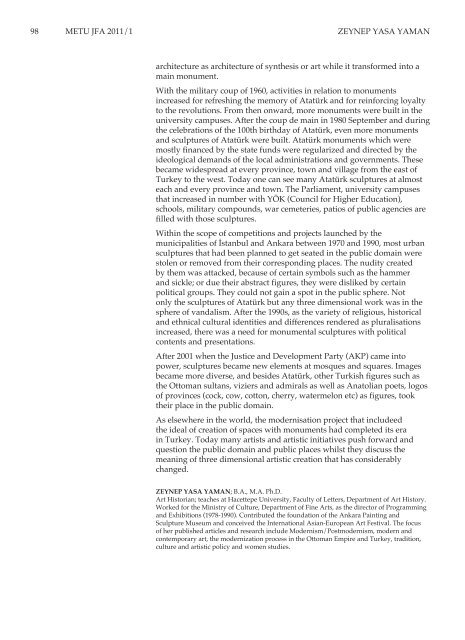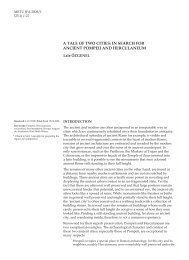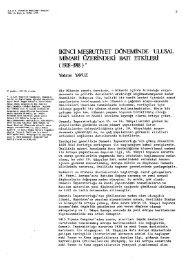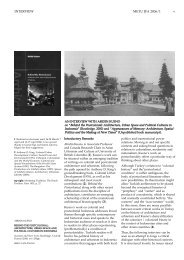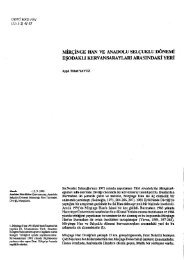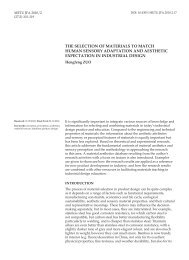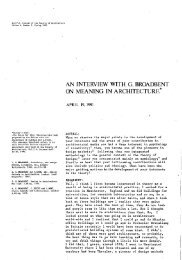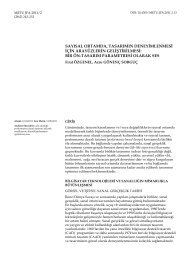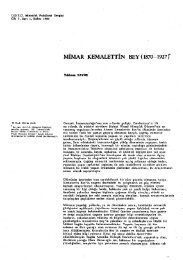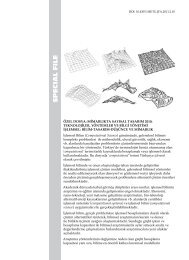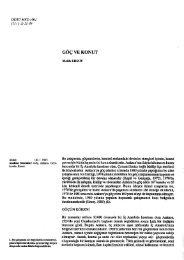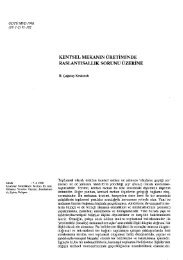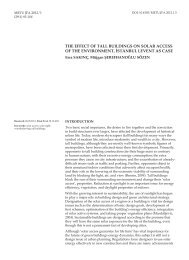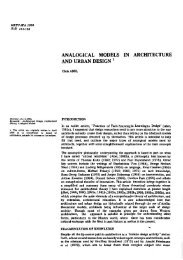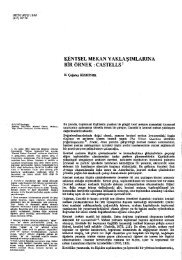siyasi/estetik gösterge - Journal of the Faculty of Architecture
siyasi/estetik gösterge - Journal of the Faculty of Architecture
siyasi/estetik gösterge - Journal of the Faculty of Architecture
You also want an ePaper? Increase the reach of your titles
YUMPU automatically turns print PDFs into web optimized ePapers that Google loves.
98 METU JFA 2011/1<br />
ZEynEP yASA yAMAn<br />
architecture as architecture <strong>of</strong> syn<strong>the</strong>sis or art while it transformed into a<br />
main monument.<br />
With <strong>the</strong> military coup <strong>of</strong> 1960, activities in relation to monuments<br />
increased for refreshing <strong>the</strong> memory <strong>of</strong> Atatürk and for reinforcing loyalty<br />
to <strong>the</strong> revolutions. From <strong>the</strong>n onward, more monuments were built in <strong>the</strong><br />
university campuses. After <strong>the</strong> coup de main in 1980 September and during<br />
<strong>the</strong> celebrations <strong>of</strong> <strong>the</strong> 100th birthday <strong>of</strong> Atatürk, even more monuments<br />
and sculptures <strong>of</strong> Atatürk were built. Atatürk monuments which were<br />
mostly financed by <strong>the</strong> state funds were regularized and directed by <strong>the</strong><br />
ideological demands <strong>of</strong> <strong>the</strong> local administrations and governments. These<br />
became widespread at every province, town and village from <strong>the</strong> east <strong>of</strong><br />
Turkey to <strong>the</strong> west. Today one can see many Atatürk sculptures at almost<br />
each and every province and town. The Parliament, university campuses<br />
that increased in number with yÖK (Council for Higher Education),<br />
schools, military compounds, war cemeteries, patios <strong>of</strong> public agencies are<br />
filled with those sculptures.<br />
Within <strong>the</strong> scope <strong>of</strong> competitions and projects launched by <strong>the</strong><br />
municipalities <strong>of</strong> İstanbul and Ankara between 1970 and 1990, most urban<br />
sculptures that had been planned to get seated in <strong>the</strong> public domain were<br />
stolen or removed from <strong>the</strong>ir corresponding places. The nudity created<br />
by <strong>the</strong>m was attacked, because <strong>of</strong> certain symbols such as <strong>the</strong> hammer<br />
and sickle; or due <strong>the</strong>ir abstract figures, <strong>the</strong>y were disliked by certain<br />
political groups. They could not gain a spot in <strong>the</strong> public sphere. not<br />
only <strong>the</strong> sculptures <strong>of</strong> Atatürk but any three dimensional work was in <strong>the</strong><br />
sphere <strong>of</strong> vandalism. After <strong>the</strong> 1990s, as <strong>the</strong> variety <strong>of</strong> religious, historical<br />
and ethnical cultural identities and differences rendered as pluralisations<br />
increased, <strong>the</strong>re was a need for monumental sculptures with political<br />
contents and presentations.<br />
After 2001 when <strong>the</strong> Justice and Development Party (AKP) came into<br />
power, sculptures became new elements at mosques and squares. Images<br />
became more diverse, and besides Atatürk, o<strong>the</strong>r Turkish figures such as<br />
<strong>the</strong> Ottoman sultans, viziers and admirals as well as Anatolian poets, logos<br />
<strong>of</strong> provinces (cock, cow, cotton, cherry, watermelon etc) as figures, took<br />
<strong>the</strong>ir place in <strong>the</strong> public domain.<br />
As elsewhere in <strong>the</strong> world, <strong>the</strong> modernisation project that includeed<br />
<strong>the</strong> ideal <strong>of</strong> creation <strong>of</strong> spaces with monuments had completed its era<br />
in Turkey. Today many artists and artistic initiatives push forward and<br />
question <strong>the</strong> public domain and public places whilst <strong>the</strong>y discuss <strong>the</strong><br />
meaning <strong>of</strong> three dimensional artistic creation that has considerably<br />
changed.<br />
ZEYNEP YASA YAMAN; B.A., M.A. Ph.D.<br />
Art Historian; teaches at Hacettepe University, <strong>Faculty</strong> <strong>of</strong> Letters, Department <strong>of</strong> Art History.<br />
Worked for <strong>the</strong> Ministry <strong>of</strong> Culture, Department <strong>of</strong> Fine Arts, as <strong>the</strong> director <strong>of</strong> Programming<br />
and Exhibitions (1978-1990). Contributed <strong>the</strong> foundation <strong>of</strong> <strong>the</strong> Ankara Painting and<br />
Sculpture Museum and conceived <strong>the</strong> International Asian-European Art Festival. The focus<br />
<strong>of</strong> her published articles and research include Modernism/Postmodernism, modern and<br />
contemporary art, <strong>the</strong> modernization process in <strong>the</strong> Ottoman Empire and Turkey, tradition,<br />
culture and artistic policy and women studies.


